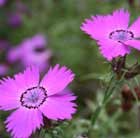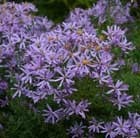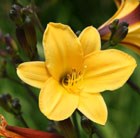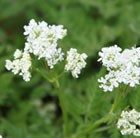Price reductions at Crocus
by Sarah - August 26th, 2009.Filed under: Crocus, Price Reductions.
Reduced products at Crocus

yarrow was £6.99 now £4.99
Position: full sunSoil: moist, well-drainedRate of Growth: fast-growingFlowering period: July to SeptemberFlowers: pinky-redOther features: fern-like leavesHardiness: fully hardyA German hybrid, which is named after, and has the same colour as the sandstone found beside the Wesser river. The pinky-red flowers emerge from bud and age to a light dusty rose or even cream. It is a shorter variety, that has a long flowering period, and this can be extended even further by removing the faded blooms. Like all the achilleas, the flowers are irresistible to butterflies, bees and other beneficial insects. Perfect for a cottage garden.Garden care: Achilleas do not like wet soil, especially in winter. Stake if necessary using bamboo canes or brushwood before the flowers appear. Cut down to the ground in late winter, but resist the urge to do this earlier, as the seed heads look lovely in the winter light. Pull out seedlings as they appear, as they rarely match the parent plant. Lift and divide large clumps in late autumn or early spring.

pink was £5.99 now £4.99
Position: full sunSoil: well-drained, neutral to alkaline soilRate of growth: averageFlowering period: July to SeptemberHardiness: fully hardyA spreading, mat-forming pink that produces bright greenleaves and single, flat, mauve flowers in late summer.  Each flower has five petals with serrated edges and a maroon stripe around the centre. Although this dianthus is short-lived, it is long-flowering. Traditionally associated with rock gardens, it looks equally at home at the front of a sunny or alpine border or softening the edges of a gravel garden. Deadheading regularly will help encourage more flowers and keep the plant looking tidy.Garden care: Incorporate lots of well-rotted manure or garden compost into the planting hole. Apply a balanced fertiliser in spring and deadhead to prolong flowering.

michalmas daisy was £5.99 now £4.99
Position: full sunSoil: fertile, moist, but well drained soilRate of growth: fast-growingFlowering period: September – OctoberFlower colour: lilac – blue with a yellow centreHardiness: fully hardyA compact Michaelmas Daisy that will form neet clumps to around 45cm tall. In late summer and autumn it is covered in masses of lilac-blue flowers with a yellow centre making it look like a colourful dome. These plants flower best in full sun, although they will tolerate a little shade and really pack a last minute punch in the front of a border. The flowers are very attractive to butterflies too so this is a great plant to include in your wildlife garden.Garden care: Cut back in late autumn after it has finished flowering and apply a generous layer of mulch.

daylily was £5.49 now £4.99
Position: full sunSoil: fertile, moist, well-drained soilRate of growth: fastFlowering period: JuneHardiness: fully hardyMasses of beautiful, golden yellow, lily-like flowers lasting one day, appear continuously in early summer on slender stems. This cheerful, yellow daylily looks great planted at the front of a sunny mixed or herbaceous border among other 'hot' colours. A compact and free flowering variety, it's ideal for the smaller garden or a large container planting. Like most hemerocallis, it is robust and easy to grow, provided you follow the tips below. Garden care: The Greek term 'hemerocallis' means 'beautiful for a day', and daylilies need regular deadheading to prolong flowering and prevent their unsightly deadheads from dominating the scene. Each stem carries several flowers, so snap off each flower as it fades. When the stem has finished flowering, cut it down to the ground. After the plant has finished flowering altogether, pull out the dead leaves. When the foliage is looking tatty, cut it down to the ground and fresh new growth will appear. Lift and divide every two years in spring to keep the rhizomes vigorous and apply a generous 5-7cm (2-3in) mulch of well-rotted garden compost or manure around the base of the plant. Water frequently from spring until the buds appear.

coral bells was £6.99 now £5.99
Position: full sun or partial shadeSoil: fertile, moist or well-drained soilRate of growth: averageFlowering period: JuneHardiness: fully hardyA terrific heuchera that's perfect for adding colour to the garden. In late spring, sprays of brownish flowers appear but this heuchera is really grown for its exciting foliage. It has rich, shiny, undulating leaves in a range of colours from amber to peachy bronze with hot pink undersides. The evergreen foliage is perfect edging a border, along a path or even in pots on the patio. Garden care: Heucheras do not like dry soil. Remove tatty foliage in autumn. Lift and divide clumps every couple of years in early autumn and replant with the crown just above the surface of the soil. Apply a generous 5-7 cm (2-3 in) mulch of well-rotted organic matter around the crown of the plant in spring.

sweet cicely was £6.99 now £5.99
Position: full sun or light dappled shadeSoil: fertile, moist but well-drained soilRate of growth: averageFlowering period: May to JuneFlower colour: whiteOther features: the leaves provide sweetness when cooked with fruitHardiness: fully hardyA hardy, aromatic herbaceous plant with bright green, deeply cut leaves that are further enhanced by the appearance of great, flat-topped clusters of tiny, white flowers in summer. These flowers ripen to produce shiny, dark brown fruits that are widely used in herbal medicine. The fern-like leaves are flecked with white and have a delicate aniseed flavour. They are often added to fruit dishes to reduce the acidity. The thick tap root can also be eaten raw or cooked as a vegetable.Garden care: Divide plants in spring or autumn. It self-seeds freely so dead-head regularly if you do not want more to come.






